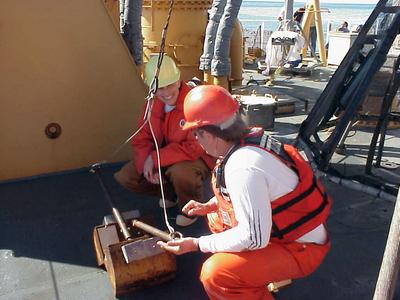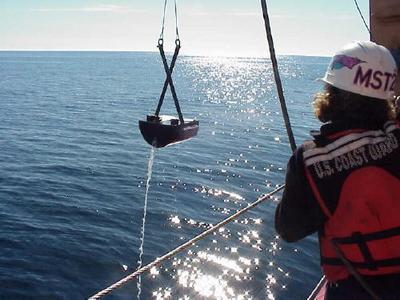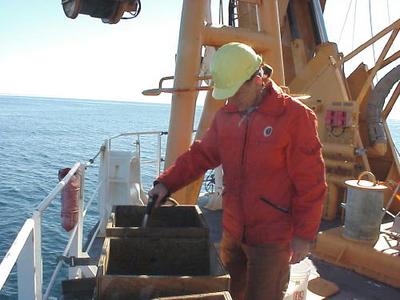19 July, 2002
My day began at 6 AM when we were scheduled to start
the next station. I knew we would have no water ready
to sample at that time, but I tend to be a bit anxious
about schedules so I arrived right on the dot of 6.
Needless to say I was early; the service cast had not
even gone into the water yet! I went back to my room
to work on my journals and computer filing of my
pictures. I returned, took my samples and made it to
breakfast by 7:30.
After lunch, it was finally time for Dr. Grebmeierís
sampling. Since she is still on the Canadian
icebreaker, the Sir Wilfrid Laurier, I worked with Jim
Bartlett, her technician, to collect and process the
benthic samples. Benthic organisms are those that live
on the bottom. Iíve included lots of pictures today
so you can see most of the process. In future days,
Iíll tell you more about the analysis; today Iíll just
describe the actual sampling procedure. As you are
reading this, keep in mind that we repeat the process
five times, the first to get samples from the top of
the mud and the other four to provide replicates
(samples taken at the same station).
We start by lowering an open van Veen grab over the
side and to the bottom. When it hits bottom, it
releases and closes, grabbing a sample of the bottom
mud. When the first sediment sample is on deck, we use
a syringe to gather a tiny mud sample for chlorophyll
analysis. After that, we remove a larger amount into a
special container called a Marinelli beaker. It has
an indentation on the bottom designed to fit onto an
instrument that measures the sample for beryllium-7
content. Once those samples have been taken we follow
the same procedure for the remaining four samples.
First we empty the mud into a large tub and rinse the
grab to be certain all the mud is cleaned out. The
sample must then be completely rinsed of mud in order
to collect any organisms (and the rocks that are often
present). To do this, we empty the tub into a large
wooden box with a wire mesh bottom and rinse
continuously until the mud is gone. Depending on the
consistency of the mud, this can be a relatively short
process or a longer one if the mud contains a lot of
clay or gelatinous (jelly-like) material that clings
to the mesh. When the mud is gone we transfer the
remaining material to a plastic container where we add
formaldehyde to preserve the specimens. The
biological samples are transferred to the University
of Tennessee for further analysis.
As you can tell, the sampling process for this
parcticular experiment is very mechanical, and much is
done literally by hand. Itís interesting to compare
our work with some of that going on around us. While
others lower sophisticated, computer-controlled
instruments into the water to sample and gather data,
we use a metal grab, buckets, sieving boxes and a
hose!
We have one more station ďtonight.Ē Technically, we
arrive at midnight, so I guess it is really a July 20
station. Most people will try to catch some sleep so
they wonít be too tired while trying to complete their
work. My job includes collecting water from the
service cast which is done right at the beginning and
then doing the benthic sampling which occurs at the
very end (we donít want to mess up other samples with
our mud in the water). It will be a long night!

This the van Veen grab used to sample benthic organisms (bottom dwellers).

The van Veen is lowered and raised on a large cable. Everyone on deck must wear a hard hat when equipment goes into the water.

When the first grab comes back on deck, we take small samples from the surface in order to test for chlorophyll. Dr. Lee Cooper (1st on the left) is helping us because Dr. Grebmeier is not on board.

Once we have made certain that the grab is cleaned of all mud, we carry the mud and water to the sieving station.

Each of the five samples must be washed until all the mud is gone and only the critters and rocks remain.
Contact the TEA in the field at
.
If you cannot connect through your browser, copy the
TEA's e-mail address in the "To:" line of
your favorite e-mail package.
|
